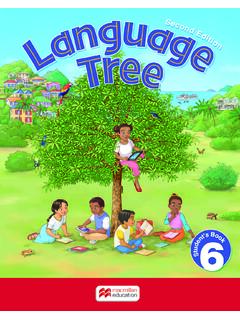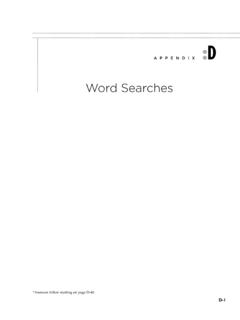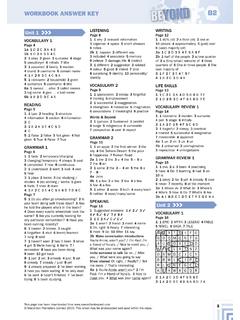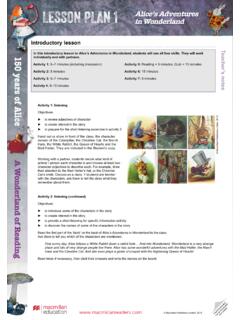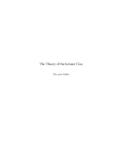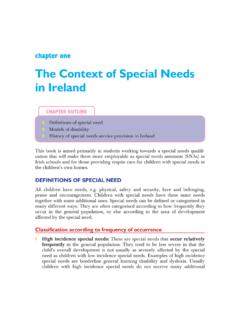Transcription of Student’s Book 3 - Macmillan Caribbean eBooks
1 Student's Book 3. Second Edition Macmillan Education 4 Crinan Street London, N1 9XW. A division of Macmillan Publishers Limited Companies and representatives throughout the world ISBN 978-1-380-00827-5 AER. Text Julia Sander 2016. Design and illustration Macmillan Publishers Limited 2016. The author has asserted her rights to be identified as the author of this work in accordance with the Copyright, Design and Patents Act 1988. This edition published 2016. First edition published 2006. All rights reserved; no part of this publication may be reproduced, stored in a retrieval system, transmitted in any form, or by any means, electronic, mechanical, photocopying, recording, or otherwise, without the prior written permission of the publishers. Designed by Macmillan Education and Blue Dog Design Studio Illustrated by Jan Smith c/o Beehive; Pamela Goodchild c/o Kearley; Anni Axworthy, Dave Hill, Bethan Matthews and Lisa Williams c/o Sylvie Poggio Cover design by Macmillan Education and Clare Webber Cover illustration by Nathalie Gavet Typeset by Tek-Art The author and publishers would like to thank the following education professionals for their valuable contributions to this edition: Suzette Abbott-King (St Vincent), Leonie Alexander-Charles (St Vincent), Ingrid Daniel- Simon (Antigua), Janelle Little (Barbados), Tessa McQuilkin (Grenada), Christina Morris (Barbados), Rochelle Richards (Antigua), Edwina Riviere (Dominica), Carla St.
2 Louis (Grenada) and Sandra Thomas (Grenada). The authors and publishers would like to thank the following for permission to reproduce their photographs: Alamy/foodfolio p54, Alamy/frans lemmens p93(tr), Alamy/Dawna Moore p89, Alamy/. National Geographic Image Collection pp4(cr), 88, Alamy/M. Timothy O'Keefe p124(bl), Alamy/Prisma Bildagentur AG p93(tl), Alamy/Rolf Richardson p55, Alamy/Julian Worker p95: Corbis/Cultura/Camarena p43; Getty Images/Murray Cooper p125, Getty Images/. Ryan McVay pp4(bm), 96, Getty Images/Mint Images - Frans Lanting p91(tr), Getty Images/Tetra images p124(tr); Joseph Jones p84; Thinkstock/Design Pics p91(br), Thinkstock/iStock/whammer121736 p93(tm). The author and publisher are grateful for permission to reproduce the following copyright material: Steel Band Jump 1994 Faustin Charles.
3 From A Caribbean DOZEN edited by John Agard & Grace Nichols. Reproduced by permission of Walker Books Ltd, London SE11 5HJ. Poem: Drinking Water Coconut by Grace Nichols. Reproduced with permission of Curtis Brown Group Ltd, London on behalf of Grace Nichols. Copyright Grace Nichols 1988. These materials may contain links for third party websites. We have no control over, and are not responsible for, the contents of such third party websites. Please use care when accessing them. Contents How to Use this Book 4. Scope and Sequence 6. Unit 1 story The Swing .. 8. Unit 2 dialogue A Special 14. Unit 3 story Going to the 20. Unit 4 traditional tale Tortoise Tries to 26. Unit 5 story Clean-up 32. Unit 6 poem Steel Band Jump 38. Looking Back 1 44. Unit 7 traditional tale Anansi 48.
4 Unit 8 letter The Class 54. Unit 9 poem Drinking Water-Coconut .. 60. story and email Unit 10 Exciting 66. environmental print Unit 11 Read the Label!.. 72. story Unit 12 All's Well That Ends 78. Looking Back 2 84. non-fiction Unit 13 Turtles .. 88. non-fiction Unit 14 The Three R's .. 94. story and speech Unit 15 The Speech .. 100. story Unit 16 Grace Goes to 106. internet page Unit 17 The Water 112. play Unit 18 The Missing 118. Looking Back 3 124. The Writing Process 128. Sample Compositions 129. Glossary 134. Skills Index 135. 3. How to Use this Book Language Tree Level 3 follows an integrated approach, and language skills in each unit develop naturally out of the reading text. Use the Student's Book alongside the Workbook and online Teacher's Resources ( ) to develop and practise important reading, listening, speaking and comprehension skills.
5 Teaching units There are 18 teaching units, each comprising the following sections: Unit 13 Turtles Get ready This section gives ideas for a class discussion Get ready which introduces the reading passage What do you know about turtles? and draws on the students' experience. What would you like to find out about them? It also draws attention to the type of text K W L. (fiction, non-fiction etc.) and introduces key What I know What I want to know What I learned vocabulary. Reading Unit 14. Reading The passages cover a variety of text types. Paragraphs Students can read independently or take it in turn to read ais section. A paragraph a group ofEncourage students sentences about a topic. to The first sentence work out usually the meaning contains the main of unfamiliar idea vocabulary of the paragraph.
6 It tells us what the from the context. paragraph is about. Comprehension questions require students 1 Work together to answer the questions. WB 3 p00. to recall detail, make inferences, draw con- How clusions, many paragraphs are there identify cause and effect, express in the reading text? What is the main idea of paragraph 1 in the reading text? personal opinions and note the differences The Leatherback Sea Turtle a) Plastic and paper take a long time betweentodifferent decay. text types. Questions canRemember! Leatherback sea turtles have lived in our oceans for 65 million years. They are the largest living turtles. They can be up to two metres long and be tackled orally b) People or ainlotwriting, throw of thingsdepending away. on often weigh more than 300 kilograms.
7 They eat jellyfish and sea plants. The other sentences in the the needs of the c) Plastic bagsclass. take 100 It may yearsbeto appropriateparagraph give details They often live more than 40 years. rot questions before askingabout the main to talk through idea. Where Leatherbacks Live toiswrite What students the main idea of to answers paragraph some of 4? them. Leatherbacks spend almost all their life in the sea. However, females always return to the beach where they hatched to lay their eggs. They nest on beaches in the West Indies, in South America and in West Africa. Main We must reduce the amount of waste we idea produce. A lot of it will not decay for more Details than 100 years. Soon, there will not be Get ready: Draw the KWL chart on the board.
8 Discuss with students and fill the first two columns with their suggestions. You will complete the third column after reading. enough space for it. 88 Pre-reading: Get students to survey the text by looking at the layout, photos and headings. Ask: What kind of text is it (fiction / fact)? What kind of information will you find in it? 2 What is the main idea of paragraph 5? What details are given 88 04/02/2016 14:32. about the main idea? Speaking and listening: discuss an issue Speaking and listening 1 What kind of waste can be recycled? Make This symbol before these two lists: exercises indicates that Things we use at home which can be recycled. students work with a partner. Things we use at school which can be recycled. Exercises include discussion, 2 How do you think we could create planning and role play.
9 Move around less waste? the class, checking on progress, or work alongside students who find oral work challenging. Speaking and listening, Exercise 1: Give students a few minutes to make their own lists, then brainstorm ideas with the class. Write a class list on the board. 96 Question 2: Allow students to contribute simple ideas, use less paper, don't use plastic bottles. 4. Walk past the supermarket and the bakery. Turn left into Hill Road. Walk past the church and the library. 2 Give directions from Terry's house to Greg's house. Language work Language: prepositions 1 Teaching points are followed by practice exercises. Prepositions are words which tell us where people or things are. Work through the example together before asking Greg went into the yard.
10 Students to work on an Exercise. Some students can Into tells us where Greg went.. write their answers independently or in pairs. You may need to work orally with other students, writing 1 Find seven prepositions in the story. all see.. the answers on a large sheet of paper which they can Example: 1 across The cat raced across the road and the dog ran after it. The cat ran into a Word work garden and climbed up a tree. The dog walked around the tree barking Unit 8 loudly. A man shouted at the dog and chased it out of the garden. Examples of word-level work, such as Word work: sequencing words Speaking vocabulary, and Listening: Prepareprefixes orworking for the Activity by homophones with the whole classare to givedrawn directions to a 21. place in your school, from your classroom to the Principal's Office.


